



















|
 |
|
 |

This page shows predominant units from Iran to Central Asia and India. Troops listed here are those you will likely face off against in rebel armies, but there are also some regional units that are available to many factions.
Gund-i Palta (Eastern Skirmishers)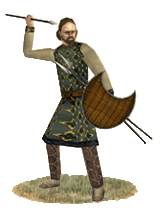 Armed with nothing but a small shield and a handful of javelins these men risk their lives in closing with the enemy with only the lightest of equipment. These men deploy in a cloud before the heavy infantry dashing back and forth to release their deadly missiles. These infantry skirmishers fought in open formations so as to maximize the number of men able to get a throw and minimize the effect of enemy missiles. Lacking armour, training and heavy weapons these light infantry stand no chance if committed to melee. Armed with nothing but a small shield and a handful of javelins these men risk their lives in closing with the enemy with only the lightest of equipment. These men deploy in a cloud before the heavy infantry dashing back and forth to release their deadly missiles. These infantry skirmishers fought in open formations so as to maximize the number of men able to get a throw and minimize the effect of enemy missiles. Lacking armour, training and heavy weapons these light infantry stand no chance if committed to melee.
Historically, most armies of the classical period found use for poorly equipped levies as skirmishers, very often as javelinmen, as these troops required relatively little training and financial investment, relying mostly on widespread natural skills and scant gear, while still providing some useful service.
Shuban-î Fradakhshana (Eastern Slingers)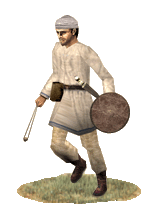 Slings are very easy and cheap to make and, yet, they are a respectable weapon. It is for this reason that they are so prevalent among the poverty-stricken hill tribes of the eastern lands. In battle, slingers are used as light skirmishers, troops with no armour or melee weapons but who rush forward against the enemy to pepper them with stones, only to flee when threatened. The best method of releasing a stone from a sling is by an underhand motion. These missiles can leave the sling in excess of 60 miles per hour. A well trained slinger can hurl a stone as far and as accurately as a good archer. The effect when they strike is nothing short of devastating. Slings are very easy and cheap to make and, yet, they are a respectable weapon. It is for this reason that they are so prevalent among the poverty-stricken hill tribes of the eastern lands. In battle, slingers are used as light skirmishers, troops with no armour or melee weapons but who rush forward against the enemy to pepper them with stones, only to flee when threatened. The best method of releasing a stone from a sling is by an underhand motion. These missiles can leave the sling in excess of 60 miles per hour. A well trained slinger can hurl a stone as far and as accurately as a good archer. The effect when they strike is nothing short of devastating.
Historically, slingers came from the shepherd boys of the highlands who use slings to herd sheep and goats. They stand guard in the upland pastures, and if they see an animal straying, they sling a stone in front of it to ward it back to safety. Ancient hand slings generally consisted of a single long strip of leather or woven wool, with a central "pocket" for the stone. The longer the sling, the greater would be its range. Long-range slings were about 3 feet long.
Thanvare Payahdag (Persian Archers)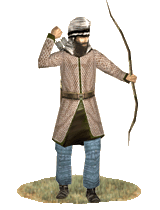 These men are skirmishers only and not inclined to close with enemy troops. These men would have the fully sleeved, long Persian Kapuris tunic. Often brightly coloured these traditional tunics would end just above the knees secured at the waist by a wide woven belt. They would also have a woolen cap, loose trousers and soft felt shoes. They would be armed with the powerful composite bow and a long dagger suitable only for defense. A plain leather quiver would be strung over their back. They would also have a simple woolen cap. These men are skirmishers only and not inclined to close with enemy troops. These men would have the fully sleeved, long Persian Kapuris tunic. Often brightly coloured these traditional tunics would end just above the knees secured at the waist by a wide woven belt. They would also have a woolen cap, loose trousers and soft felt shoes. They would be armed with the powerful composite bow and a long dagger suitable only for defense. A plain leather quiver would be strung over their back. They would also have a simple woolen cap.
Historically, the mainstay of the Parthian infantry were foot archers. These foot archers almost certainly represented the poorer elements of the various infantry levies of Parthia. The tradition of mounted archery in Parthia and the northern steppe peoples makes it almost inevitable that a massed levy would produce significant numbers of foot archers as well. The station usually assigned to these Parthian bowmen is behind the first line of spearmen and forward of them in skirmishing lines. These troops are vital to any armies plan, harassing and confusing enemy troops as they advanced, and shielding the flanks of the battle line from light cavalry and other enemy skirmishing units.
Tabargane Eranshahr (Eastern Axemen)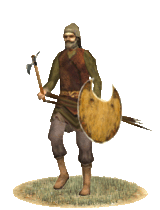 The Tabargân are steadfast warriors, aggressive and impetuous in temperament, valued by Iranians, and Hellenes alike for their ferociousness and courage. These hillmen are recruited as irregulars from the mountains of Iran, not least from the Zagros and Elburz ranges, areas that breed toughness and have done so for centuries. Though certainly not as disciplined as Hellenic heavy infantry, nor even comparably attired, They are armed with the Sagaris, or the "Persian pick-axe" (Ironically being Scythian in origin) which they wielded with skill, and a bundle of javelins, they were prepared for guerilla warfare tactics such as ambushes, surprise attacks and particularly fond of broken terrain where disciplined troops accustomed to fighting in formation would fare badly. This is facilitated by their light attire, as they bear no armour and the only true means of protection is a light shield, nimble movement and dauntless impetus, casting themselves into the fray. Distinguished by traditional Iranian highlander garb such as the Kyrbasia cap, baggy trousers, a woolen tunic, boots and a thick sheep-skin jerkin, these tough hillmen could almost be mistaken for shepherds or nomadic herders. However these hardy hillmen are nothing to scoff at, as the pick-axe could puncture helmets, and penetrate bronze and iron armour. The Tabargân were no less skilled with their javelins, in which the usage of javelin-thongs increased the stopping power and accuracy of the javelin, giving it a spin during flight. Using them properly, they will give a good account of themselves. Using them poorly on the other hand may prove suicidal and their dauntless bravery may quickly turn into fragile bravado. The Tabargân are steadfast warriors, aggressive and impetuous in temperament, valued by Iranians, and Hellenes alike for their ferociousness and courage. These hillmen are recruited as irregulars from the mountains of Iran, not least from the Zagros and Elburz ranges, areas that breed toughness and have done so for centuries. Though certainly not as disciplined as Hellenic heavy infantry, nor even comparably attired, They are armed with the Sagaris, or the "Persian pick-axe" (Ironically being Scythian in origin) which they wielded with skill, and a bundle of javelins, they were prepared for guerilla warfare tactics such as ambushes, surprise attacks and particularly fond of broken terrain where disciplined troops accustomed to fighting in formation would fare badly. This is facilitated by their light attire, as they bear no armour and the only true means of protection is a light shield, nimble movement and dauntless impetus, casting themselves into the fray. Distinguished by traditional Iranian highlander garb such as the Kyrbasia cap, baggy trousers, a woolen tunic, boots and a thick sheep-skin jerkin, these tough hillmen could almost be mistaken for shepherds or nomadic herders. However these hardy hillmen are nothing to scoff at, as the pick-axe could puncture helmets, and penetrate bronze and iron armour. The Tabargân were no less skilled with their javelins, in which the usage of javelin-thongs increased the stopping power and accuracy of the javelin, giving it a spin during flight. Using them properly, they will give a good account of themselves. Using them poorly on the other hand may prove suicidal and their dauntless bravery may quickly turn into fragile bravado.
Historically, the northern Iranian highlands are known for their hardy mountaineers who held all transgressors at bay. These men of the mountains were lightly ruled by all Persian Grandees who valued their warrior skills over what meagre income their mountain homes might bring. These men would be recruited from the warlike Gîlânî and Dailamî tribesmen of Verkhânâ (Hyrcania), and other similar peoples of northern Media. The earliest origins of these people are unknown, although the Dailamites could be the descendants of such ancient peoples as the Delumďoi (Delumioi) and Karduchoi (Kadousioi or the Cadusians) mentioned by Ptolemy in 2 AD. Classical historians mention Dailamites, 'Dolomites' or other very similar names repeatedly and their name is particularly mentioned in context with the later Byzantine Varangian Guard. Due to the mingling of migrant tribes with the indigenous residents of the region, several new clans were formed, of which, the two tribes of 'Gill' and 'Daylam' formed a majority. In the 6th century BC, the inhabitants of Gîlân allied with Kűroush (Cyrus) the Great and overthrew the Medes helping to establish the Achaemenid Persian Empire. The Dailamites would later during the Sassanid dynasty form a core of heavy infantry with fine equipment including brightly painted shields and two-pronged javelins, meant to be pitted against the finest Roman infantry. However, that is a long way from the continuously more declining irregular force, the Takâbarâ as they were called by the Achaemenids, and in Parthian history, the Tabargân are merely the residue of the Iranian highlander spirit, not exclusive to the Elburz range but to all areas of Iran where the environment breeded toughness.
Asabaran-i Madaen (Median Medium Cavalry)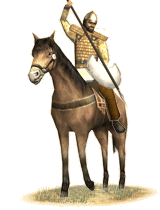 In the Seleucid and Bactrian armies, these medium Median cavalrymen are very prevalent. Descended from the lesser Persian nobility they now render good service to their new masters. They are excellent medium cavalry, capable of skirmishing, charging, and fighting fairly well in melee. These cavalry are raised from the old Persian estates that had not seized by the Macedonian invaders. They are equipped with a cavalry spear and the single bladed Tabar axe with a vicious back-spike, well capable of penetrating heavy armor. The battle-axe was often used, especially by North Iranians. The spear was usually used over arm as a thrusting weapon. The shield used by these horsemen was the crescent shaped Scythian Taka shield. A conical Persian helmet of iron is worn with brightly colored helmet plume. Their armor is a scale cuirass with scaled shoulder guards and stiffened leather pteruges hanging from the waist. Loose richly embroidered trousers and a long sleeved tunic extending down to just above the knees, is secured by a leather belt. The horse has a stuffed Persian saddle and thick, bright colored saddle cloth. The tails were tied up to prevent it being grabbed by the enemy. The forelock was left long and tired with ribbon to form a plume above the head. In the Seleucid and Bactrian armies, these medium Median cavalrymen are very prevalent. Descended from the lesser Persian nobility they now render good service to their new masters. They are excellent medium cavalry, capable of skirmishing, charging, and fighting fairly well in melee. These cavalry are raised from the old Persian estates that had not seized by the Macedonian invaders. They are equipped with a cavalry spear and the single bladed Tabar axe with a vicious back-spike, well capable of penetrating heavy armor. The battle-axe was often used, especially by North Iranians. The spear was usually used over arm as a thrusting weapon. The shield used by these horsemen was the crescent shaped Scythian Taka shield. A conical Persian helmet of iron is worn with brightly colored helmet plume. Their armor is a scale cuirass with scaled shoulder guards and stiffened leather pteruges hanging from the waist. Loose richly embroidered trousers and a long sleeved tunic extending down to just above the knees, is secured by a leather belt. The horse has a stuffed Persian saddle and thick, bright colored saddle cloth. The tails were tied up to prevent it being grabbed by the enemy. The forelock was left long and tired with ribbon to form a plume above the head.
Historically; The Macedonians came to Persia as invaders, sharing neither a common culture nor a common enemy. These lesser nobles are quick to make cause with any rebel, and the Greek upper class know this well. The Seleucids, and Baktrians intent on Hellenizing Iran, cannot rely on these men who are descended from a proud tradition, the Huvaka, Kinsmen cavalry who had faced Alexander the Great during late imperial times. It is for this reason that the Greeks often preferred to rely on mercenaries and Greek settlers, but these men are still able to be used in some roles and are conscripted in times of need. Some of these minor noble houses have intermarried with their Macedonian overlords and are thus somewhat more loyal than their neighbours might be. Still, they are often present in native revolts, due to the fact that they can often lead these revolts and have fewer opportunities due to their Iranian blood.
Kofyaren-i Verkhana (Hyrkanian Hillmen)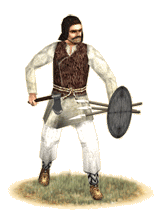 Kôfyâręn-î Verkhânâ, or Hyrcanian Hillmen are bands of warriors from the various clans in Hyrcania (Northern Iran, by the shores of the Southern Caspian Sea). These men are highly adept at guerrilla warfare and can serve a general, be he Hellene or Iranian, as fierce light infantry. They wear simple tunics and are armed with spears, axes and shields. They are fierce warriors and will give a good account of themselves, but more elite, disciplined infantry will come better out of it in combat. They represent the basis of the later elite Deilamite infantry who fought like heavy infantry, often pitted against the finest Roman infantry, during the later Byzantine-Persian wars. While the current Hyrcanian hillman begs to differ from the green-clad and sometimes heavily armoured Deilamites of Sassanid times, their weapons of choice remained essentially the same, where their distinguished traditional skills with the tabarzin (Axe) was retained, their javelins developed into a fierce two-pronged combat spear attached to thongs for both skirmishing and melee, and their simple shields developed into a large, oval and brightly painted shields. These men were also given longswords in Sassanian times making them a very versatile infantry, and indeed Sassanian combat infantry where hallmarked by versatility, being equipped for both melee and skirmishing. Usually at the sacrifice of elaborate armour. Kôfyâręn-î Verkhânâ, or Hyrcanian Hillmen are bands of warriors from the various clans in Hyrcania (Northern Iran, by the shores of the Southern Caspian Sea). These men are highly adept at guerrilla warfare and can serve a general, be he Hellene or Iranian, as fierce light infantry. They wear simple tunics and are armed with spears, axes and shields. They are fierce warriors and will give a good account of themselves, but more elite, disciplined infantry will come better out of it in combat. They represent the basis of the later elite Deilamite infantry who fought like heavy infantry, often pitted against the finest Roman infantry, during the later Byzantine-Persian wars. While the current Hyrcanian hillman begs to differ from the green-clad and sometimes heavily armoured Deilamites of Sassanid times, their weapons of choice remained essentially the same, where their distinguished traditional skills with the tabarzin (Axe) was retained, their javelins developed into a fierce two-pronged combat spear attached to thongs for both skirmishing and melee, and their simple shields developed into a large, oval and brightly painted shields. These men were also given longswords in Sassanian times making them a very versatile infantry, and indeed Sassanian combat infantry where hallmarked by versatility, being equipped for both melee and skirmishing. Usually at the sacrifice of elaborate armour.
Historically, the northern Iranian highlands are known for their hardy mountaineers who held all transgressors at bay. These men of the mountains were lightly ruled by all Persian Grandees who valued their warrior skills over what meagre income their mountain homes might bring. These men would be recruited from the warlike Gîlânî and Dailamî tribesmen of Verkhânâ (Hyrcania), and other similar peoples of northern Media. The earliest origins of these people are unknown, although the Dailamites could be the descendants of such ancient peoples as the Delumďoi (Delumioi) and Karduchoi (Kadousioi or the Cadusians) mentioned by Ptolemy in 2 AD. Classical historians mention Dailamites, 'Dolomites' or other very similar names repeatedly and their name is particularly mentioned in context with the later Byzantine Varangian Guard. Due to the mingling of migrant tribes with the indigenous residents of the region, several new clans were formed, of which, the two tribes of 'Gill' and 'Daylam' formed a majority. In the 6th century BC, the inhabitants of Gîlân allied with Kűroush (Cyrus) the Great and overthrew the Medes helping to establish the Achaemenian Persian Empire. Hyrcania itself was mainly rough and hilly which in turn (and also because it was relatively poor) meant the nomads of the Central Asian steppes bypassed it. The Hyrcanians themselves controlled the mountain passes in the region and it seems the different steppe peoples made arrangements with the Hyrcanian rulers to use these passes when they went raiding, often to fall upon peoples the Hyrcanians disliked, and also when retreating back to the steppes. Hyrcania was more or less independent during Seleukid rule (Dubbed “Hyrkania” according to Hellenic naming conventions), while under Pahlavan rule the Pahlava took more direct control, which was the reason the Hyrcanians were often in revolt and Hyrcania was considered an unruly area.
Asiatikoi Hippakontistai (Eastern Light Cavalry)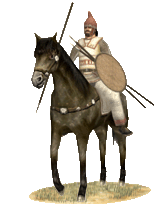 These Asiatikoi horsemen represent a light, but versatile unit well able to skirmish and to perform screening duties. They have their uses in pursuit and thanks to their skills in using spears in melee, they are also the bane of light infantry. As light auxiliaries, they are also armoured with a linen corselet giving them light protection and more staying power than most other light cavalry. They are not suited for combat-intensive tasks, and will root if bogged down in melee, in particular against heavier contenders, whether they be mounted or on foot. Their low morale is also marked by the fact that these men often enlisted as mercenaries measuring loyalty by the amount of gold. These Asiatikoi horsemen represent a light, but versatile unit well able to skirmish and to perform screening duties. They have their uses in pursuit and thanks to their skills in using spears in melee, they are also the bane of light infantry. As light auxiliaries, they are also armoured with a linen corselet giving them light protection and more staying power than most other light cavalry. They are not suited for combat-intensive tasks, and will root if bogged down in melee, in particular against heavier contenders, whether they be mounted or on foot. Their low morale is also marked by the fact that these men often enlisted as mercenaries measuring loyalty by the amount of gold.
Historically, the Epigonoi were originally thoroughly Hellenized Persians, a part of Alexander's plan in fusing together Hellenic and Iranian traditions. Even if its originator's death put a dent to the success of that plan, this later extended to native Mesopotamians, Iranians and Scythians who were prevalent around the Near East. Epigonoi would be the Hellenzsed Asians who were born and raised by their non-Hellenic parents in Hellenistic poleis, who could speak Greek and be part of the Hellenistic world. Most of whom, however, weren't given that chance, thus turning to soldiery as a means to sustain themselves. Later on they would revenge the Hellenistic world for this injustice by turning into rebels or joining their enemies. As such, their equipment, albeit light, reflect local traditions in a military sense: They are armed like Hippakontistai or mounted skirmishers, armoured with a lineothorax, and a Phrygian cap. They are armed with a bundle of javelins and a thrusting spear for melee combat. As such, this unit represent Eastern horsemanship and attire, in combination with Hellenistic equipment.
Asiatikoi Hippeis (Medium Eastern Cavalry)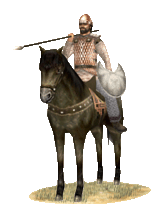 These medium cavalry represent a versatile task-force well able to perform a wide range of roles in battle. They are excellent screeners well-suited to guard the flanks of a battle-line, well able to cut lighty armed horsemen to ribbons, as well as their qualities in pursuit. Such qualities would make them a worthwhile addition to any commander. They are armed with a thrusting spear, which they bear in an overhanded manner, and a vicious axe with a back-spike allowing them several advantages in melee. As such they are also suited for flanking and supportive roles. Still however, they are not well-suited to take on heavier cavalry or elite infantry formations, and their loyalty is only marked by the measured weight of gold. These medium cavalry represent a versatile task-force well able to perform a wide range of roles in battle. They are excellent screeners well-suited to guard the flanks of a battle-line, well able to cut lighty armed horsemen to ribbons, as well as their qualities in pursuit. Such qualities would make them a worthwhile addition to any commander. They are armed with a thrusting spear, which they bear in an overhanded manner, and a vicious axe with a back-spike allowing them several advantages in melee. As such they are also suited for flanking and supportive roles. Still however, they are not well-suited to take on heavier cavalry or elite infantry formations, and their loyalty is only marked by the measured weight of gold.
Historically, these horsemen were prevalent around Asia Minor, the Near East, and further eastwards, marking them as an ethnically diverse contingent consisting of "Eastern" peoples, including Medeans, Persians, Albanians, Iberians, Armenians, Cappadocians and Syrians willing to fight for any wealthy master in exchange for whatever that may feed their horses and themselves for a longer term. As such, their equipment and clothing would also have differed, though not always were such horsemen drastically diverse in ethnical disposition. Comparatively they may be seen as a heavier variation of Pantodapoi horsemen.
Nizagan-i Eranshahr (Persian Archer-Spearmen)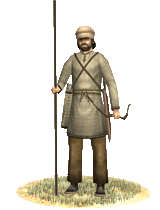 Armed with spear and bow these troops are not well regarded by their Greek masters having formed the bulk of the Old Persian army defeated by Alexander the Great. Seen as skirmishers and auxiliaries with the heavy Greek infantry forming the battle line. These Iranian Spearmen are recruited from the eastern reaches of the Iranian plateau and are very common in the armies of Baktria. They are the backbone of the traditional tribal militia and form a major part of the Baktrian tribal levy. They are armed with the traditional Iranian weapons, an 8' spear and a composite foot bow. A large decorated brown leather quiver of arrows would be slung on the left side with the bow case on the right. A long plain yellow tunic with close fitting sleeves at the wrists. The tunic would be held with an narrow embroidered Parthian linen belt. Trousers are worn under the tunic and are close fitting. Soft felt ankle shoes are secured with leather or fabric straps. Armed with spear and bow these troops are not well regarded by their Greek masters having formed the bulk of the Old Persian army defeated by Alexander the Great. Seen as skirmishers and auxiliaries with the heavy Greek infantry forming the battle line. These Iranian Spearmen are recruited from the eastern reaches of the Iranian plateau and are very common in the armies of Baktria. They are the backbone of the traditional tribal militia and form a major part of the Baktrian tribal levy. They are armed with the traditional Iranian weapons, an 8' spear and a composite foot bow. A large decorated brown leather quiver of arrows would be slung on the left side with the bow case on the right. A long plain yellow tunic with close fitting sleeves at the wrists. The tunic would be held with an narrow embroidered Parthian linen belt. Trousers are worn under the tunic and are close fitting. Soft felt ankle shoes are secured with leather or fabric straps.
Historically, the vast Iranian plateau gave rise to a form of infantry rarely seen in the west. Armed with 8' spear and composite short bow these infantry are well suited to conditions in the east facing nomadic enemies relying on long range archery to which they men are well able to respond. Nomadic cavalry is reluctant to engage close order troops and these men can fill both roles. They are versatile and can be dangerous if used properly. They are however no match for heavily armored infantry. Individually, they are skilled but not outstanding warriors, but their versatility ensures that they will be useful to any commander. These men however, prefer to rely on archery to inflict harm on the enemy. They can hold the line against weaker infantry and cavalry but they cannot be relied upon to put up an extended fight if the situation is not in their favor.
Kardaka Arteshtar (Persian Hoplites)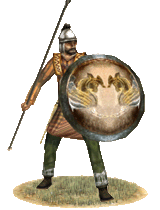 The Kardaka are armed with the Iranian longsword, and a long thrusting spear. These guards also carried the large hoplon-shaped shield known as the Aspis. The armour to protect the torso was usually composed of iron scales and was worn over a brightly decorated tunic hanging down to just above the knees, however this was far from uniform so any rudimentary armour, including bronze scales, linen and even quilted cloth could suffice depending on individual wealth or the available equipment of the local armouries. As the Kardakâ, originally a late Achaemenid imitation of a hoplite, grew to become gradually more Hellenized, in particular during Seleucid times where the linen corselet also known as the linothorax became more popular. Their grey iron helm would have a slightly oval thimble shape though here it is shown as an Eastern version of a modular Attic helmet, with protection for the neck, particularly popular around Lycia and Cilicia. They would have loose trousers and short light brown leather boots. They would also have a thick linen cloak of dark blue or deep red. Well drilled, close order infantry these men form the core of most eastern armies. They were however relegated to garrison duty in Parthian service. They are capable and disciplined troops. The Kardaka are armed with the Iranian longsword, and a long thrusting spear. These guards also carried the large hoplon-shaped shield known as the Aspis. The armour to protect the torso was usually composed of iron scales and was worn over a brightly decorated tunic hanging down to just above the knees, however this was far from uniform so any rudimentary armour, including bronze scales, linen and even quilted cloth could suffice depending on individual wealth or the available equipment of the local armouries. As the Kardakâ, originally a late Achaemenid imitation of a hoplite, grew to become gradually more Hellenized, in particular during Seleucid times where the linen corselet also known as the linothorax became more popular. Their grey iron helm would have a slightly oval thimble shape though here it is shown as an Eastern version of a modular Attic helmet, with protection for the neck, particularly popular around Lycia and Cilicia. They would have loose trousers and short light brown leather boots. They would also have a thick linen cloak of dark blue or deep red. Well drilled, close order infantry these men form the core of most eastern armies. They were however relegated to garrison duty in Parthian service. They are capable and disciplined troops.
Historically, these troops were a late imperial Persian attempt to make a native Hoplite like infantry. These men come from the old Persian core Satraps of Persis and Media, willing to serve the Seleucids as easily as the encroaching Parthians. They are versatile in the sense of providing a reliable platform, fending off cavalry and faring decently in close combat, without being restricted by the inflexible Macedonian phalanx, making them some of the finest infantry to the disposal of the Pahlavân. Still it must be remembered that while they can give a good account of themselves as heavy infantry, they will likely turn out to be inferior to comparable Hellenic infantry, and should therefore be used a little bit differently by Eastern armies who rely more on cavalry; The Kardakâ may rather be used as an auxiliary rather than as the backbone of an Eastern army. The Kardakâ or Cardaces/Kardakes as they were called by Greek sources were subject to a wide range of different accounts regarding their combat performance, between being mediocre to full-fledged elites and equally their equipment, in particular their shields ranged from the hoplon to the more traditional wicker shields. Though it can be argued that the Kardakâ must have retained some uniformity during Achaemenid times, with the royal treasuries withdrawn and being deployed by Eastern nations who have rather turned their eyes towards cavalry, they do also inevitably represent a continuously declining unit type.
Khuveshavagan (Persian Heavy Cavalry)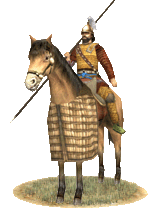 The Khűveshâvagân used to be the most expensively attired cavalry in the world, and were indeed the sign of the equestrian power of the Achaemenid world order. With the coming of Macedonian cavalry tactics, the Khűveshâvagân had undergone several changes. The final product was an extra-heavy cavalry unit, magnificently equipped with the finest technology mustered by the Achaemenids. Financed by the royal treasuries, they were made into a contingent of specific honour, The Kinsmen. Armed with a xyston, and a machaira along with the deployment in column formation, this unit was purely equipped for melee combat, like the later cataphracts. The mount being barded with peytrel, chamfrôn and the parameridia or armoured saddle, made this unit a particularly headstrong opponent worthy of respect. The Khűveshâvagân used to be the most expensively attired cavalry in the world, and were indeed the sign of the equestrian power of the Achaemenid world order. With the coming of Macedonian cavalry tactics, the Khűveshâvagân had undergone several changes. The final product was an extra-heavy cavalry unit, magnificently equipped with the finest technology mustered by the Achaemenids. Financed by the royal treasuries, they were made into a contingent of specific honour, The Kinsmen. Armed with a xyston, and a machaira along with the deployment in column formation, this unit was purely equipped for melee combat, like the later cataphracts. The mount being barded with peytrel, chamfrôn and the parameridia or armoured saddle, made this unit a particularly headstrong opponent worthy of respect.
With the royal treasuries withdrawn and the adoption of additional Macedonian conventions, the Khűveshâvagân are no longer "Kinsmen" per se. Only in appearance have most of the fearsome features been retained. Still heavily armoured they make a respectable contender, and a reliable heavy cavalry they are only truly inferior to the proper cataphracts in the matter of equipment and tactics. Armed with a xyston and a machaira this full-contact unit can mount a terrible charge, wreaking havoc upon the enemy and additionally being clad entirely in bronze and the horse being armoured with an exotic combination of chamfrôn, peytrel and the parameridia, it must certainly have been a most impressive unit, both an ornament to whomever affording these warriors and a fearsome enemy. However, the unit being in decline (Due to being financed by nobles rather than the royal treasury) and increasingly archaic vis-a-vis to the torrent of improved cavalry equipment being developed in the steppes, will make this unit only useful as an option of heavy cavalry before cataphracts can be fielded.
Historically, the late Achaemenian heavy cavalry was an amalgam between Iranian horsemanship and an increasingly higher need for resilient and headstrong cavalry for shock tactics. Chariots, in particular scythed were most fearsome with a ample support, specifically heavy cavalry. The cavalry reforms of the latter half of the 5th century reached its apex during the patronage of the Persian Commander-in-Chief Pharnabazus, distinguished through Xenophon as a capable general, where the Persian "Cuirassiers" were not lined up for close combat but rather organized in columns for a sustained momentum in a charge. In accordance with the relief of Bozkir and some clear depictions of a parameridia (The armoured saddle), and earlier mention of horse armour in the form of peytrel and chamfrôn (As a nose-plate), this cavalry must have been quite heavily armoured. This cavalry, other than being depicted as the bodyguard of Cyrus The Younger during the civil war of Achaemenid Persia, was about to get a second overhaul, a step closer to the heavily armoured cataphracts of later Iranian dynasties. By then, the Persian army was beginning to become more Hellenized, which included certain Greek sabres.
During 372 BCE, Datames replaced Pharnabazus as the Commander-in-Chief of the Persian armies, and other than being accredited for the concept of a Persian hoplite'esque troop type, the Cardaces, Xenophon in his written work "Horsemanship", does not only recommend the parameridia, but also lauds an invention called "The arm", a very possible and likely addition of laminated armour, or as they are called in Greek, the "cheires". It is often suggested that Seleucid heavy cavalry came to adopt the banded/laminated armour for the arms from the Achaemenians. However, before the demise of the Achaemenians, a third reform was made during the reign of Darius III Codomannus, after the battle of Issus. Modelled after previous Achaemenid as well as Bactrian style armour, and combined Sakae and Macedonian cavalry tactics, the Hűvakâ of Darius was an interesting, but nonetheless fearsome amalgam. By the end of the Achaemenid dynasty, the Persians had two types of shock cavalry, the most popular undoubtly the scythed chariot often pulled by armoured horses and lead by heavily armoured crew. The second being an exotic variety of extra-heavy cavalry, household but also recruited from the Bactrians, Massagetae, Sakae, Cappadocians, Armenians and even westernly Scythians. The interesting aspect is that instead of completely relying on local traditions, the Achaemenians pursued their own reforms of the heavy cavalry. While for most of its lifespan being more of a extra-heavily armoured skirmisher cavalry with the ability to mount a charge in column formation, it evolved into a unit meant for full contact. It was aptly named the "Hűvakâ", meaning "The Kinsmen", something translated by Pahlavî as "xwesawand" or "Khűveshâvagân".
Naturally this would also require not only great physique and vigour of the mountee, but the requirements of the mount would be more strict as well. A horse, able to support a heavily armoured rider and some barding needed to be heavy-boned, tall, and muscular. Historically, by the end of the Achaemenian era, Persian emperors were given tribute, often in the form of horses. Cyrus The Great himself valued horses besides good weapons and chariots, as quoted from Herodotus. The main breeds for heavier cavalry were the Cappadocians, as earlier trained to serve as mounts for the famed Lydian lancers and subsequently the Perso-Hellenic kingdom of Pontus, as well as the Armenian horses known for their resilience, and finally the Mede and Parthian (Nisaean) breeds, in which especially the latter was not only known as perhaps the bulkiest of horses but also remarkably speedy, said to outrun the Iberian horses used by the Romans. Therefore it would seem that Achaemenian cavalry tradition formed the basis of subsequent Armenian and Pontic heavy cavalry, as well as providing the Seleucids with a vast range of not only heavy cavalry auxiliaries but also a variety of mounts. The Armenians and the Persian nobles of Pontus, being greatly influenced by Persian trends would most certainly have continued the tradition.
As a means of support for chariots, it could facilitate the sheer violence of the chariot charge as written by Xenophon: "The soldiers had got into the habit of collecting their supplies carelessly and without taking precautions. And there was one occasion when Pharnabazus, with 2 scythed chariots and about 400 cavalry, came on them when they were scattered all over the plain. When the Greeks saw him bearing down on them, they ran to join up with each other, about 700 altogether; but Pharnabazus did not waste time. Putting the chariots in front, and following behind them himself with the cavalry, he ordered a charge. The chariots dashing into the Greek ranks, broke up their close formation, and the cavalry soon cut down about a hundred men. The rest fled and took refuge with Agesilaus, who happened to be close at hand with the hoplites." (Xenophon Hellenica IV,1,17-19)
Thanvare Parsig (Heavy Persian Archers)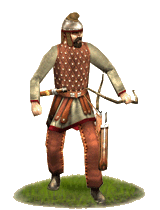 These archers are the result of numerous Achaemenid Persian reforms, in themselves more or less inspired by Greek military traditions. They wear a soft, padded cap of leather, often of the ingenious kyrbasia design, in addition to their armour which could either have been quilted cloth, leather or quilted leather, often studded with bronze or iron rivets, offering some rudimentary protection without compromising too greatly on mobility. This may at first seem like quite needless additions, however understanding the Achaemenid military structure and relationship between the defensive contingents, the spearmen, and the archers as well as how they interacted as a unit in their decimal formation, reveals that the additions were vital and in this formation, the Persian archers were renowned, not only for their skill and marksmanship but also their discipline, with the formation being instrumental in outlasting their enemies when exchanging volleys. With the Achaemenid world order not existing anymore, Iranian archery traditions have remained strong in spite of Hellenic martial traditions, and will serve Hellenes and Easterners alike. Replacing their simple bows with a Scythian-influenced composite bow, they have greater range and penetrating power than their Achaemenid forebears and with their basic armour are not as vulnerable as their more lightly equipped brethren, neither in volley exchanges nor in melee. Still, they are not by any means capable of sustaining themselves against melee infantry and as such are only meant to be used as an auxiliary. These archers are the result of numerous Achaemenid Persian reforms, in themselves more or less inspired by Greek military traditions. They wear a soft, padded cap of leather, often of the ingenious kyrbasia design, in addition to their armour which could either have been quilted cloth, leather or quilted leather, often studded with bronze or iron rivets, offering some rudimentary protection without compromising too greatly on mobility. This may at first seem like quite needless additions, however understanding the Achaemenid military structure and relationship between the defensive contingents, the spearmen, and the archers as well as how they interacted as a unit in their decimal formation, reveals that the additions were vital and in this formation, the Persian archers were renowned, not only for their skill and marksmanship but also their discipline, with the formation being instrumental in outlasting their enemies when exchanging volleys. With the Achaemenid world order not existing anymore, Iranian archery traditions have remained strong in spite of Hellenic martial traditions, and will serve Hellenes and Easterners alike. Replacing their simple bows with a Scythian-influenced composite bow, they have greater range and penetrating power than their Achaemenid forebears and with their basic armour are not as vulnerable as their more lightly equipped brethren, neither in volley exchanges nor in melee. Still, they are not by any means capable of sustaining themselves against melee infantry and as such are only meant to be used as an auxiliary.
Historically, the Iranian plateau has always bolstered a fine archery tradition where the rugged environment encouraged skills in using missile weaponry. During all four native Iranian dynasties of Iran, archery has always been valued, however prior to the great Iranian migrations, peoples such as the Elamites were lauded for their archery skills, especially by the conquering Assyrians who had faced them in battle. The Elamite skills did not wane by the destruction of their kingdom, but survived well into the Neo-Elamite era where they established connections with the Persians and the Medes. During the Achaemenid era, the Elamites were accorded a position of honour as skilled archers, even though they were not allowed to either bear the akinâkâ, a gilded short sword, or to enlist as the Ânűsîyâ, or the 10,000 Immortals. As a result, archery was in general a praised practice, something not exclusive to the Iranians among who the Achaemenians added it as one of their three virtues, but to the native peoples who lived there as well. The Achaemenid military organization was clearly made to facilitate archery, where a satâbam, or one hundred men, would mainly consist of archers who from the second rank (As the first rank consisted of spearmen who formed a defensive wall with the spârâ which in turn a decorated pavise of wicker) would continuously increment the angle, to the tenth rank. This would require a great discipline and a good number of junior officers, also ranked accordingly in a decimal manner to coordinate the formation properly. The wicker shields would be vital in outlasting the enemies in volley exchanges, but individual additions of armour facilitated this effect as well.
Kofyaren-i Kavakaza (Baktrian Light Infantry)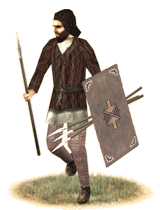 Many Iranian peoples inhabit the hills and mountains around Central Asia. As the nomads advance into these lands, they often avail themselves to these tough hillmen who can operate in lands that even a steppe pony may have difficulty. Armed with javelins and an axe, and armored only by a small buckler, these soldiers, like most Eastern infantry can not hope to survive in a fight against either settled infantry or nomadic cavalry. Even so, they can do heavy damage against unwary opponents, and are far more manuevarable than armor-laden heavy infantry. Willing to fight for most people who control their lands in return for money and booty, they can help the often infantry-challenged nomads even the odds in more conventional battles as well as sieges. Many Iranian peoples inhabit the hills and mountains around Central Asia. As the nomads advance into these lands, they often avail themselves to these tough hillmen who can operate in lands that even a steppe pony may have difficulty. Armed with javelins and an axe, and armored only by a small buckler, these soldiers, like most Eastern infantry can not hope to survive in a fight against either settled infantry or nomadic cavalry. Even so, they can do heavy damage against unwary opponents, and are far more manuevarable than armor-laden heavy infantry. Willing to fight for most people who control their lands in return for money and booty, they can help the often infantry-challenged nomads even the odds in more conventional battles as well as sieges.
Historically, Baktrian hillmen or at least soldiers like them have been around in the same lands for many years, serving the Persians and now the Greeks. From the earliest states to emerge in Central Asia to the recent establishments of Hellenic kingdoms, troops like these have often been levied for support infantry duty or just to fill the ranks of the army with greater numbers.
Gund-i Nizagan (Parthian Spearmen)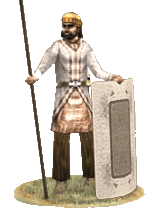 These poorly trained, levy infantry are supplied by the great nobles (Azads) from their estates in the more settled regions of the Persian Empire. They are armed with an infantry spear and brown, leather-covered, wicker shield, a smaller version of the old spara (gerron) of imperial days, and a short sword or axe. Their primary order of battle would consist of spearmen fighting in ordered ranks. Groups of spearmen such as these are trained to form rows across and files deep and to march in step. Grouping together bolsters morale and the shield wall helps to neutralize arrows. However, the oft-repeated myth of 'roped or chained' Persian troops is an invention of literature. The Arabic term 'silsilah' is very likely a poetic device meant to imply soldiers organized into close order units. The same term is used to refer to both Sassanid Persian and Byzantine cavalry, neither of which could have conceivably been physically tied together in groups! These poorly trained, levy infantry are supplied by the great nobles (Azads) from their estates in the more settled regions of the Persian Empire. They are armed with an infantry spear and brown, leather-covered, wicker shield, a smaller version of the old spara (gerron) of imperial days, and a short sword or axe. Their primary order of battle would consist of spearmen fighting in ordered ranks. Groups of spearmen such as these are trained to form rows across and files deep and to march in step. Grouping together bolsters morale and the shield wall helps to neutralize arrows. However, the oft-repeated myth of 'roped or chained' Persian troops is an invention of literature. The Arabic term 'silsilah' is very likely a poetic device meant to imply soldiers organized into close order units. The same term is used to refer to both Sassanid Persian and Byzantine cavalry, neither of which could have conceivably been physically tied together in groups!
Historically, the Parthian Nobility displayed the same distrust of armed peasantry as many other feudal elites, The Gund-î Nîzagân were as close as they came to putting that uncomfortable idea into practice, but these foot troops were generally drawn from the poorer classes of Parthian society and were often badly equipped and barely trained. When the indifferent quality of these troops was added to the pace of Parthian warfare, it meant that the Nizag Gund would rarely be committed to heavy action. Their duties would generally include garrison and baggage guard, but they could also form a spear wall in pitched battles.
Shivatir-i Pahlavanig (Parthian Horse-Archers)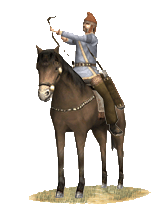 These cavalrymen are recruited from the clan warriors of Parthia, and originally come from the steppes of Central Asia. Although they now live in Iran, they still learn to ride as soon as they can walk like their ancestors. They are expert archers and expert horsemen, being able to shoot a bow accurately from horseback, and they are the masters of the ‘Parthian shot’, being able to shoot backwards at full gallop. They are best used at weakening enemy formations so that the heavy cavalry can finish them off. Almost impossible to destroy and unwilling to come to grips with well ordered infantry these horsemen use marauder tactics to bring down their enemies. Dense formations of infantry are their favoured target. These cavalrymen are recruited from the clan warriors of Parthia, and originally come from the steppes of Central Asia. Although they now live in Iran, they still learn to ride as soon as they can walk like their ancestors. They are expert archers and expert horsemen, being able to shoot a bow accurately from horseback, and they are the masters of the ‘Parthian shot’, being able to shoot backwards at full gallop. They are best used at weakening enemy formations so that the heavy cavalry can finish them off. Almost impossible to destroy and unwilling to come to grips with well ordered infantry these horsemen use marauder tactics to bring down their enemies. Dense formations of infantry are their favoured target.
Historically, the Pahlava Shivatir formed the backbone of all Parthian armies. Led by the Dehbed minor nobility into battle, these Bandaka (bondsmen or retainers) rely on missile fire as their primary asset. They used probably the best weapon for the light horseman, which was the composite horse bow. It was similar to the simple self bow but used multiple layers of wood, horn and sinew to produce a stronger bow with a greater draw weight—the force built up in the string that will propel the arrow forward to its target— for a small size.
Asabaran-i Hauravatish (Arachosian Skirmisher Cavalry)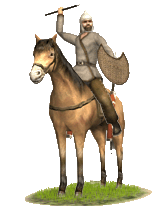 These horsemen from Arachosia are best used in a harassing role and can be very useful trying to tempt enemy heavy cavalry to mount a charge in a vain attempt to catch them. They would be wearing the Persian Kyrbasia, a soft grey-white cloth cap extending down around the neck, made of fabric and able to be pulled down over his face when marching through desert regions. They would wear dirty grey sheepskin coats with bright embroidered trim. They would wear baggy embroidered dark red trousers and knee high, brown leather boots. A coarse rain resistant felt cape, or cherkesska was also donned in winter. Also worn was a leather belt with elaborate buckles, which are decorative in themselves and used to support weapons. They would have a spear and 3-4 javelins in two embossed leather cases mounted just behind the saddle on either side. Up to as many as 6-8 such javelins cold be carried in all the cases. Their protection would be enhanced by a small crescent shaped 'Taka' shield. The brightly coloured saddle cushion would be u-shaped and made of sheepskin or cloth and stuffed with straw. These horsemen from Arachosia are best used in a harassing role and can be very useful trying to tempt enemy heavy cavalry to mount a charge in a vain attempt to catch them. They would be wearing the Persian Kyrbasia, a soft grey-white cloth cap extending down around the neck, made of fabric and able to be pulled down over his face when marching through desert regions. They would wear dirty grey sheepskin coats with bright embroidered trim. They would wear baggy embroidered dark red trousers and knee high, brown leather boots. A coarse rain resistant felt cape, or cherkesska was also donned in winter. Also worn was a leather belt with elaborate buckles, which are decorative in themselves and used to support weapons. They would have a spear and 3-4 javelins in two embossed leather cases mounted just behind the saddle on either side. Up to as many as 6-8 such javelins cold be carried in all the cases. Their protection would be enhanced by a small crescent shaped 'Taka' shield. The brightly coloured saddle cushion would be u-shaped and made of sheepskin or cloth and stuffed with straw.
Historically; Armed chiefly with javelins these horsemen hail from Arachosia, Baktria, Sogdiana, and similarly equipped light cavalry was supplied by the levy from Persis and Media. The flexible nature of this light cavalry makes them well suited to the fluid, aggressive style of warfare so common on the eastern frontiers. Mounted on a swift horse, armed with nothing but a small crescent shaped 'Taka' shield, short spear, and a handful of javelins these swift moving horsemen can be deadly. Their small, nimble mountain ponies can negotiate most terrain easily, and they're capable enough to survive contact with the enemy, but their strength remains in maintaining their loose style of fighting. Equipped with javelins these cavalry would advance on their target at less than a gallop. As each rank came into range, these warriors would turn away, hurling their javelins at the target, and retire to safety before the enemy could retaliate. The result is often a swirling mass of charging and counter charging horsemen as the light horse would reform to charge again.
Daha Rog Baexdzhyn Aefsad (Dahae Skirmisher Cavalry)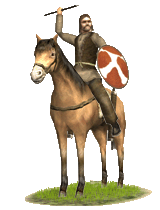 These Dahae skirmisher cavalry are best used in a harassing role and can be very useful in tempting enemy heavy cavalry to mount a charge in a vain attempt to catch them. They carry an abundant supply of javelins in saddle-cases. The traditional role of mounted archers is well known, but the heavier javelin is more dangerous to armoured opponents. These wild tribesmen fill a vital role in the clan host. While they do make excellent skirmishers, this is not their only calling. They are warriors of the steppe and wield spears with skill and courage, willing to close with the enemy when the odds are in their favour. These Dahae skirmisher cavalry are best used in a harassing role and can be very useful in tempting enemy heavy cavalry to mount a charge in a vain attempt to catch them. They carry an abundant supply of javelins in saddle-cases. The traditional role of mounted archers is well known, but the heavier javelin is more dangerous to armoured opponents. These wild tribesmen fill a vital role in the clan host. While they do make excellent skirmishers, this is not their only calling. They are warriors of the steppe and wield spears with skill and courage, willing to close with the enemy when the odds are in their favour.
Historically, the Daha tribes of eastern Iran are part of the vast conglomerate of Iranian-speaking steppe nomads and members of the great tribal amalgam that spawned the Parni tribe, better known to history as Parthians. By 270 BC the Dahae had spread into northern Margiana, Sogdiana and south of the Aral Sea. While they fielded many horse archers, the javelin was commonly used as well because it had greater piercing power and heavier equipment was getting more and more common on the steppe.
Daha Baexdzhyntae (Dahae Riders)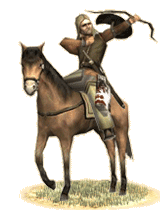 Dahae Riders carry a long spear and a shield besides their bows and are willing to press home a charge if circumstances are right. Even more significantly, they maintain a very useful tactical flexibility as they can skirmish and put their bows to very good use against solidly formed enemies that would repulse a headlong charge. As such, they are some of the finest light horsemen available to the Arsacid Kings of Parthia, the Hellenistic monarchs of Baktria, powerful nomadic rulers or anyone who manages to have them as either mercenaries, allies or nominal subjects. Dahae Riders carry a long spear and a shield besides their bows and are willing to press home a charge if circumstances are right. Even more significantly, they maintain a very useful tactical flexibility as they can skirmish and put their bows to very good use against solidly formed enemies that would repulse a headlong charge. As such, they are some of the finest light horsemen available to the Arsacid Kings of Parthia, the Hellenistic monarchs of Baktria, powerful nomadic rulers or anyone who manages to have them as either mercenaries, allies or nominal subjects.
Historically, the Daha, which is the Persian word for "robbers", were a tribe who held the lands to the northeast of Persia. The Parthians themselves were a branch of this people. In common usage the term was used to denote any of the nomadic raiders who made life difficult for the settled peoples of Persia. These raiders would descend on Persian settlements and villages to pillage and burn when the opportunity presented itself. They would be mounted on the steppe pony, renowned for it's courage and endurance. These animals only needed to be watered once a day, and they could dig for grass under the snow, which eliminated the army's need to carry feed. These are strong animals, twelve or thirteen hands high, with powerful chests and necks, large hook-nosed heads and well-built legs; they had a very fast gait. they were hardy and invaluable for long distances. astride small shaggy ponies Many of these horses could carry their masters a hundred miles between dawn and sunset and the same horse would pass the night unsheltered, in pouring rain and sub-zero temperatures, without taking harm from these harsh conditions. As such they are some of the finest light horsemen available to the Arcsacid Kings of Parthia.
Yancai Uaezdaettae (Alan Nobles)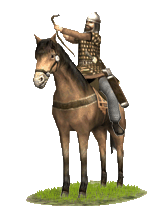 Yancai Nobles represent one of the many variations of Central Asian cavalry that combine a long, two-handed lance and a composite bow. This offensive gear can be accompanied by very variable amounts of protection for both horse and rider, from no armour at all for either to full metal scale corselets and bardings. Yancai Nobles are relatively closer to the “light” end along this continuum, with unprotected horses and the riders wearing padded leather jackets with pieces of metal sewn over it. Consequently, they can suffer from missiles or protracted combat against heavier opponents. In exchange, what they wear gives good protection for a reasonable expense and, being relatively light, still allows these troops to rely on speed and agility. Their charges are furious and effective, but they should be repeated, rather than left them mired in melee. Yancai Nobles represent one of the many variations of Central Asian cavalry that combine a long, two-handed lance and a composite bow. This offensive gear can be accompanied by very variable amounts of protection for both horse and rider, from no armour at all for either to full metal scale corselets and bardings. Yancai Nobles are relatively closer to the “light” end along this continuum, with unprotected horses and the riders wearing padded leather jackets with pieces of metal sewn over it. Consequently, they can suffer from missiles or protracted combat against heavier opponents. In exchange, what they wear gives good protection for a reasonable expense and, being relatively light, still allows these troops to rely on speed and agility. Their charges are furious and effective, but they should be repeated, rather than left them mired in melee.
Historically, armoured cavalry had a long tradition in Central Asia warfare being present in peoples like Massagetae, Sakae, etc. since long. Apparently, sometime in the 4th century BCE, probably due to the contact with hard-charging Makedonian cavalry during Alexander’s campaigns, this cavalry evolved into a troop type that, in different forms, would remain an integral part of warfare for centuries to come: the mounted lancer. The Yancai, a group of Iranian nomads probably related, if not descended from the Massagetae and who at I AD became the better known Alans, were practitioners of this style of warfare and contributed to its spread westwards.
Duna Asya (Saka Horse-Archers)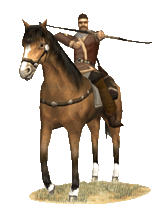 These are tough Saka from the north-eastern frontiers of the Parthian Empire and the lands beyond. Living a tough life, they learn to ride as soon as they can walk, and they are masterful horsemen. The Saka nomad's primary weapon is the composite bow, the new asymmetrical so called 'Hunnish' bow rather than the Scythian composite bow. The steppe pony they ride is a hardy beast, though small and shaggy. Considered unattractive by more settled folk, it is well able to survive in the harsh steppe climate and can thrive on grass alone, not requiring the daily grain feed of more finely bred mounts. This allows their nomadic riders to range far and wide, not hampered as more traditional cavalry would be. These are tough Saka from the north-eastern frontiers of the Parthian Empire and the lands beyond. Living a tough life, they learn to ride as soon as they can walk, and they are masterful horsemen. The Saka nomad's primary weapon is the composite bow, the new asymmetrical so called 'Hunnish' bow rather than the Scythian composite bow. The steppe pony they ride is a hardy beast, though small and shaggy. Considered unattractive by more settled folk, it is well able to survive in the harsh steppe climate and can thrive on grass alone, not requiring the daily grain feed of more finely bred mounts. This allows their nomadic riders to range far and wide, not hampered as more traditional cavalry would be.
Historically, Saka cavalry fought both within and against Parthian armies. Shooting accurately with a bow while on horse-back took long training and, thus, many “Parthian” mounted bowmen were levied from the vassal tribes on the Empire’s border marches, who were renowned for their horsemanship and fighting skill. Most Saka horsemen in Parthian service were part of contingents supplied by tribal allies/subjects, but some might have been mercenaries. Occasionally, they appear to have formed their own units and fought under their own chieftains. In any case, they have their own sense of loyalty and cannot be relied on to fill important roles. They could be used, though, to bulk up the line of horse archers in a Parthian, providing the Parthian Kings with another vital source of light cavalry. When fighting for themselves, the Saka proved a force to be reckoned with. Hostile Saka managed to slay two Parthian kings in battle and when the Parthians finally drove them out, they coalesced with related groups of nomads from further east to overran Northern India, forming the Indo-Saka kingdoms there.
Paya Hinam Dunai Purma (Subeshi Archers)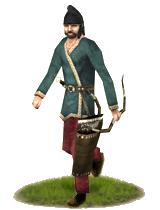 These Subeshi Archers are foot bowmen. Wearing a felt helmet, leather leggings and a thick sheepskin coat with the wool turned inside, they also carry a recurved composite bow in a leather case and arrows with wooden, bone, bronze and iron tips. The bows they carry are a larger version of the Scythian recurved composite bow, enabling them to outrange, outshoot and outpower steppe nomad horse archers, making these foot bowmen the ideal counter to horse archers in a stationary exchange of missiles with the latter. However, despite their advantages in returning fire from the ground, they are extremely vulnerable to heavy infantry and cavalry charges and are suited to harassment and support roles as at close quarters they merely wield a short sword, the akinakes of Scythian origin. These Subeshi Archers are foot bowmen. Wearing a felt helmet, leather leggings and a thick sheepskin coat with the wool turned inside, they also carry a recurved composite bow in a leather case and arrows with wooden, bone, bronze and iron tips. The bows they carry are a larger version of the Scythian recurved composite bow, enabling them to outrange, outshoot and outpower steppe nomad horse archers, making these foot bowmen the ideal counter to horse archers in a stationary exchange of missiles with the latter. However, despite their advantages in returning fire from the ground, they are extremely vulnerable to heavy infantry and cavalry charges and are suited to harassment and support roles as at close quarters they merely wield a short sword, the akinakes of Scythian origin.
Historically, the people of a state known in Han times as the "Gushi" - which is now considered most likely to be a state in the Turfan oasis to the northeast of the Tarim, were described as a semi-nomadic people. Though they lived in tents and searched for pastures they still had considerable knowledge of agriculture. It was also said that these people owned cattle, horses, camels, sheep and goats. Interestingly, they were said to have also been proficient with bows and arrows and were noted for harassing travelers who happened to take the northern Silk Route from the kingdom of Loulan in the eastern Tarim through the oases south of the Tianshan. This serves as testimony to their semi-nomadic nature and these archers who hail from Subeshi, a place most likely to have been controlled by the Gushi, are representative of these skilled semi-nomadic archer warriors.
Hindus Pattisainya (Indian Spearmen)
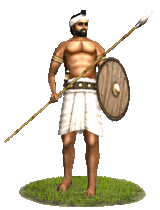 All across the lands of the East the tribes of the Hindus have spread themselves, teaming across a region larger even then the empire of the conqueror Alexandros himself. Despite their far-flung habitation, the practice of war was much the same among most of them. These Hindus Pattisainya are a fine brigade of lightly armed spearmen drawn from a number of tribes like the Gandharas and those that the Hellenes called the Aspasios, or even the Yaudheya beyond the Hindus itself. Their tribal differences occassionally spring up, but by and large they are united by their common religion - mostly some form of Buddhism, but often enough they can find accomodations with their own local or shared gods. Though armed only with a light shield and a bamboo spear, they are well suited to combat in a number of regions, and are incredibly useful auxiliaries. All across the lands of the East the tribes of the Hindus have spread themselves, teaming across a region larger even then the empire of the conqueror Alexandros himself. Despite their far-flung habitation, the practice of war was much the same among most of them. These Hindus Pattisainya are a fine brigade of lightly armed spearmen drawn from a number of tribes like the Gandharas and those that the Hellenes called the Aspasios, or even the Yaudheya beyond the Hindus itself. Their tribal differences occassionally spring up, but by and large they are united by their common religion - mostly some form of Buddhism, but often enough they can find accomodations with their own local or shared gods. Though armed only with a light shield and a bamboo spear, they are well suited to combat in a number of regions, and are incredibly useful auxiliaries.
Historically, the infantry employed by Hindus kings like Ambhi, the two Purushotthama kings of Kekeya (the two Paurava kings), or even the far off dynasts of the Audumbaras and Yaudheyas, was dominated by light armed levies like these. Particularly among the former peoples in Gandhara and farther North among the Southern Kambojas, where class restrictions on warfare were more relaxed, and peasant levies more prevelant. They fought valiantly for their kings when men like Megas Alexandros brought his campaign to the banks of the Hindus, and even more so in their own ancient epics of battle and spiritual awakening. Later on, they fought for Alexandros himself in contingents provided by his vassals, and at various times in the armies of Indo-Greek kings like Menandros and Antialkidas. In these later times, they were a huge and formidable component of Indo-Hellenic armies, but had more restricted or varied origins. Under Menandros, they were probably heavily drawn from the Madras, Sibis, Kekeyas, and other Gandhara peoples - though local levies from among the Yaudheyas, Audumbaras, and other Buddhist peoples of his massive empire - while the armies of Zoilos or Lysias probably included more peoples of the West-Central Hindus region. Later, under the Saka, they probably served mostly as light garrison or support troops for their countrymen in the archer corps or the King's Hellenic infantry.
Hindus Patiyodha (Indian Longbowmen)
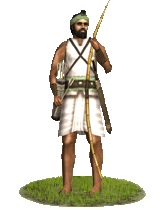 The Hindus tribes west of the Indus are famed for their use of massive longbows made from cane and strung with tough silken bowstrings. These bows allow them to launch arrows at a tremendous range, making their users essentially immune to enemy horse archers and projectiles. They wear no armor and rely simply on their skills with the large Indian sword to get them out of less certain melee encounters. These Indians can be the lynchpin of a proper 'wearing down' before a dedicated melee engagement, thinning the ranks that the more dedicated melee fighters will encounter. The Hindus tribes west of the Indus are famed for their use of massive longbows made from cane and strung with tough silken bowstrings. These bows allow them to launch arrows at a tremendous range, making their users essentially immune to enemy horse archers and projectiles. They wear no armor and rely simply on their skills with the large Indian sword to get them out of less certain melee encounters. These Indians can be the lynchpin of a proper 'wearing down' before a dedicated melee engagement, thinning the ranks that the more dedicated melee fighters will encounter.
Historically, the longbowmen of India were a famous and fearsome force, utilized by every effective army ever mobilized in the region - even Alexander the Great took advantage of their easy availability, receiving a number of them in the levy contingents from his newly acquired vassal kings. A century later, as the Baktrian Kings became more settled and grew into the roles of a "Raja," as opposed to a traditional Hellenic Basileos, such archers became a more regular component of their native levy - probably freeing most Hellenes from the lower orders of the psiloi, in order to concentrate them in their "national" phalanx. Even the archery-oriented Saka used them to augment their own foot archers, or to support their cavalry divisions, expanded as more and more cultivated land came under their power. Forunately for the Baktrians, Saka, and even the occassional non-regional power to invade India, longbowmen are a regular feature of the local military infrastructure, and easily accessable to anyone.
Sreni Pattya Yoddaha (Infantry Guild Warriors)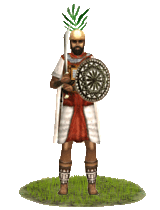 Self regulating professional guilds, called ‘Sreni’ formed an important part of the social fabric of the Indian sub-continent in the 3rd century B.C. Some of these were guilds of war-craft, and their members dedicated their lifetime to the art of war, conducting their affairs according to a strict code of ethics. Self regulating professional guilds, called ‘Sreni’ formed an important part of the social fabric of the Indian sub-continent in the 3rd century B.C. Some of these were guilds of war-craft, and their members dedicated their lifetime to the art of war, conducting their affairs according to a strict code of ethics.
These infantry are equipped with the best that money can buy. For defense, they wear armour of iron and brass scales over a quilted cotton cuirass, with additional protection for the arms, legs and shoulders. For offense, they carry a large ‘sword-axe’ made of high quality iron from the mines of Magadha. At this point in history, the metal-craft of Magadha was well in advance of anything in the Mediterranean and so the equipment was of very high quality.
Heavily armoured, steeped in a warrior tradition and bound by a professional code of warrior ethics, these troops can be relied on to hold the battle line in the most trying of circumstances.
Historically, most of what we know of ancient Indian armies comes from Kautilya’s ‘Arthashastra’ (a manual on statecraft) and sparse depictions in Buddhist art (notably at Barhut and Ajanta). Kautilya makes it clear that troops from the ‘Sreni’ formed an integral part of the royal army and were trusted second only to the king’s own standing army. Scattered references from our sources also indicate that professional mercenary companies from India were in regular employment, fighting for and against the Achaemenids, and later for and against Alexander and his successors.
Elephantes Indikoi (Indian Elephants)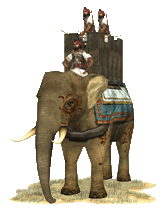 Imported from the regions around the old Eastern Persian provinces, Elephantes Indikoi are an exceptionally valuable resource in combat, very popular among Alexandros' Diadochoi. Towering over most other creatures, they can easily scare men and horses alike, with both their size and smell, though elaborate bells and trappings often add to their intimidation. Such corps are directed by their own mahouts riding behind their heads, often a native of their own country who has spent at least two years training his beast from capture. The mahout is armored to better protect against the obvious assault that generally comes against him, launched to bypass the thick natural armor of his mount. Imported from the regions around the old Eastern Persian provinces, Elephantes Indikoi are an exceptionally valuable resource in combat, very popular among Alexandros' Diadochoi. Towering over most other creatures, they can easily scare men and horses alike, with both their size and smell, though elaborate bells and trappings often add to their intimidation. Such corps are directed by their own mahouts riding behind their heads, often a native of their own country who has spent at least two years training his beast from capture. The mahout is armored to better protect against the obvious assault that generally comes against him, launched to bypass the thick natural armor of his mount.
Elephants are best used as cavalry screens for your army, where their presence can scare away enemy cavalry. They can also be used to ram through an enemy battle line, though they are less useful when faced with loose order or phalanx infantry. Pyrrhos of Epeiros even innovated a tactic of flank screens when he fought the Romans at Heraklea. Beyond their obvious use against enemy infantry or cavalry, they can also be used in siege combat; battering down gates, though they're highly vulnerable to better prepared installations. Their greatest vulnerability is against skirmishers, slingers and archers, who can pepper them with missiles - eventually toppling them by virtue of their cumulative impact. To counter the effect of enemy skirmishers, it is often wise to array your own in opposition, or to maintain constant attacks upon each individual group.
Historically, the use of elephants in war was largely contained to India, but after the battle of Hydaspes that changed. Though Alexandros never cared over much for the animals, his successors were very much in favor of their use, organizing their own elephants into a distinct corps under their own "elephantarchos". These "Elephantes Indikoi" (Indian Elephants) were imported for war in the West from the old Eastern Persian provinces around Baktria, Gandhara, Sattagydia, and Sind - though most originally hailed from the regions directly around the river the natives call the Sindhu. In the first wars of succession, each Diadochoi had a contingent of Indian elephants and Indian mahouts, who stayed on where they taught the Hellenes how to capture and train elephants for war. Such forces had been wreaking havoc on battle lines for centuries within the armies of Indian Rajas, and the Diadochoi used them on an equal scale (the first substantial group supposedly numbered 500 elephants total, granted to Seleukos I Nikator by his new ally Chandragupta Maurya, called "Sandrokottos" in Greek), attaching substantial political power to their possession - some officers gained temporary power and success simply by this virtue (most notably, the Eastern Satrap Eumenes).
Despite their great usefulness when properly employed, it was not unusual for elephants to cause defeat for those who employed them. If an enemy was clever enough to devise their own means to combat elephants, as was the case at the battle of Gaza when Ptolemaios planted an ‘iron spiked minefield’ to ward off elephants, or when Caesar properly utilized slingers and Scipio gaps between his infantry cohorts to channel the elephants, they could be defeated and even turned against their masters. Even pigs were used on occasion, released among elephants who were often scared of their comparatively small, darting forms. However, despite the many different weapons and stratagems being devised to fight them and the huge expenses required to maintain them, the elephant was still considered a valuable asset, maintained widely. The Arche Seleukeia even developed a corps of ‘elephant guards,' whose task was simply to defend the beasts in combat.
Other non-Hellenic powers also used Indian elephants in war, but it seems not to the same great extent. These powers started using elephants when they gained control of Indian provinces, such as the Pahlava, Kushan Empire and the Indo-Saka kingdoms.
Kamboja Asvaka Ksatriya (Indo-Iranian Light Cavalry)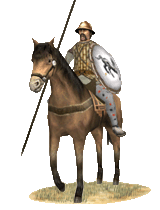 Master horsemen and horse traders, Kambojas never leave an opportunity to plunder using their light horse troops. Living on both sides of the Khyber Pass, they were a part of the "Arya" races which stormed and conquered India, some 1500 years before. Their own name was a mistaken identity by the Helllenes of Alexandros who called them "Assakenoi" whereas they were "Asvaka" or "horsemen" in Sanskrit. Losing badly to Alexander, they befriended his descendants, their Greco-Baktrian overlords and along with them they invaded India reaching as far as present day Bangladesh. They repeated this feat, but with their new Lords, the Sakae who overran Greek Baktria in the end of 1st centrury BCE. Their helmet is an evolved Boiotian one, and their primary cuirass is a quilted silk one. Untreated (so called "dirty") silk had very good anti-missile qualities, which Kambojas facing Indian foot archers and Steppen Horse archers would deffinitely appreciate. They wear Iranian dotted pantaloons and have pteryges to cover their genitals. Their weapons are clearly Hellenic: round "Aspis" shield, a short kontos spear that could be held underarm in a stance reminding that of the knights, and a sturdy kopis for the time when the spear gave way. It is safe to assume that they would show the same faith to all their overlords, whoever they might be. Master horsemen and horse traders, Kambojas never leave an opportunity to plunder using their light horse troops. Living on both sides of the Khyber Pass, they were a part of the "Arya" races which stormed and conquered India, some 1500 years before. Their own name was a mistaken identity by the Helllenes of Alexandros who called them "Assakenoi" whereas they were "Asvaka" or "horsemen" in Sanskrit. Losing badly to Alexander, they befriended his descendants, their Greco-Baktrian overlords and along with them they invaded India reaching as far as present day Bangladesh. They repeated this feat, but with their new Lords, the Sakae who overran Greek Baktria in the end of 1st centrury BCE. Their helmet is an evolved Boiotian one, and their primary cuirass is a quilted silk one. Untreated (so called "dirty") silk had very good anti-missile qualities, which Kambojas facing Indian foot archers and Steppen Horse archers would deffinitely appreciate. They wear Iranian dotted pantaloons and have pteryges to cover their genitals. Their weapons are clearly Hellenic: round "Aspis" shield, a short kontos spear that could be held underarm in a stance reminding that of the knights, and a sturdy kopis for the time when the spear gave way. It is safe to assume that they would show the same faith to all their overlords, whoever they might be.
Historically, Kamboja, were among the westernmost of the 16 or so nations (mahajanapadas) which comprised the Archaic (Vedic) Indian world. IndoIranians to the utmost, they presumably took the name from river Kabul (then named Kaboj) or from Kam(region)-used mostly in those areas to this date- and Bhoja(owner). They must have a major impact on the Achaimenid Persians who conquered them, as Cyrus the great (Kurush) named his son Kambyses (Kambujiya) the 3rd, presumably after a Mythical hero, Kambujiya (Kamboja of Shantiparava),who led the Iranians against a Vedic king Kuvalashava, defeating him in the battle and wresting a prized sword from his lineage. Thus, it can be easily understood that common language and mythical bonds made Achaimenids and Kambojas friendly to one another.
This good relation with their overlords would change later, as the Kamboja clans - the Aspasioi of Kunar/Alishang valleys, the Guraeans of the Guraeus (Panjkora) valley and the Assakenoi of the Swat and Buner valleys fought the Makedones to a man. When worse came to worst, even the Assakenoi(Ashvakayanas) Kamboj women had taken up arms and fought the invaders side by side with their husbands, thus preferring "a glorious death to a life of dishonor". In fact Alexander spent a couple of years at present day Afghanistan and NW Pakistan fighting Kamboja clans. These highlanders, designated as "parvatiya Ayudhajivinah" in Panini's Astadhyayi were rebellious, fiercely independent and freedom-loving clans who never easily yielded to any overlord. Modern historians have this to say on them ...."It was indeed a hard work for Alexander to take their strongholds, of which Massaga and Aornus need special mention (A. K. Narain, 'Alexander the Great') and "A tribute must be made to the vision and sagacity of Alexander because he realised that without reducing these highlanders, his march into India would neither be secure nor effective."(History of Punjab, Vol I, 1997, p 225, Dr Buddha Prakash). This was the wonder and the tragedy of those people. That they controled the way to India, thus they had to be either conquered or destroyed.
Taxilan Agema (Indo-Iranian Heavy cavalry)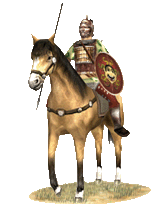 Heavy cavalry, exclusive to the Gandhara region, those mostly Indo-Iranian horsemen combine elements of both Hellenic weapon and armor mastery, and Indian excellent iron forging traditions. Wearing a Hellenic facemask made to resemble the syncretic deity of Zeus-Ahura Mazda with his distinct outflowing sunrays, armed with a small "cavalry" aspis shield, a spear and a kopis for close work and a leather cuirass, those alone would classify him a heavy cavalry. Yet, worn above the leather cuirass is the true Mauryan ion forging skills evident. Right on the edge of the facemask begin a circular leather shoulder and neck protector, with iron and bronze scales intertwined. His cloak, heavy at the shoulders for enhanced slash protection is basically two parts, that are tied together prior to battle. On top of his leather cuirass, a wooden frame is held together by leather straps. Therein either metal shards or rectangular lamellae are held together by the wooden frame, making a very Indian style "framed breastplate", on top of his hardened leather cuirass. An Iranian style pantaloon and perikneimeides' also known as greaves complete the picture. Heavy cavalry, exclusive to the Gandhara region, those mostly Indo-Iranian horsemen combine elements of both Hellenic weapon and armor mastery, and Indian excellent iron forging traditions. Wearing a Hellenic facemask made to resemble the syncretic deity of Zeus-Ahura Mazda with his distinct outflowing sunrays, armed with a small "cavalry" aspis shield, a spear and a kopis for close work and a leather cuirass, those alone would classify him a heavy cavalry. Yet, worn above the leather cuirass is the true Mauryan ion forging skills evident. Right on the edge of the facemask begin a circular leather shoulder and neck protector, with iron and bronze scales intertwined. His cloak, heavy at the shoulders for enhanced slash protection is basically two parts, that are tied together prior to battle. On top of his leather cuirass, a wooden frame is held together by leather straps. Therein either metal shards or rectangular lamellae are held together by the wooden frame, making a very Indian style "framed breastplate", on top of his hardened leather cuirass. An Iranian style pantaloon and perikneimeides' also known as greaves complete the picture.
Historically, closely after Alexandros died, his Indian pocessions became the property of one of the greatest Indian dynasties to come out of the Magadha area, the Mauryans, named after its founder Chandragupta Maurya. Be it his immitating of the tolerant Seleukid ways, be it that he felt gratitude toward the "Yavanas/Yonakas" mercenaries who helped him assume the throne, Chandragupta Maurya, allowed free reign on all. This is further demonstrated by his grandson Asoka Maurya, in his Bilingual (Greek and Aramaic) inscriptions at Kandahar/Gandahara (Shar-i-kuna). (3rd century BCE). They were preserved at the Kabul Museum.
Today they have disappeared. There he had written among other verses which proclaimed abstaining from killing..."and obedient to their father and mother and to the elders, in opposition to the past also in the future, by so acting on every occasion, they will live better and more happily". It has been suggested that Ashoka has had a quarter Greek blood, as his grandfather Chandragupta did marry Seleukos' daughter, but that is beside the point. It may be that his supposed quarter Greek ancestry did make him more hospitable towards Yavanas and other Northwestern "barbarians", but it is more prudent to assume that Ashoka had studied government, and had learned about Seleukos forging a kingdom out of nothing through "tolerance" and "synthesis" of foreign elements. This process would come to be known thousands of years later in a land far far away as "E pluribus unum".
It is rare that a fusion of cultures, ideas, religions and yes, warrior cultures happens. It is however very fortunate that in the cases that it does, units that combine all the great aspects of their perspective "schools of thought" so far as military technology of the time. The Greek facemask, maybe the best form of facial protection at the time would start a legacy that would last for at least 1500 years across all Asia. The small round shield, by no means a Greek invention, is still in use in India, in Kalaripayattu martial arts discipline. Kopis sword, is now known as Khukri and the resemblance to the Kopis is uncanny. The cuirass has certainly evolved away from what the Taxilan Agema wear. A heavy Nissean or Kambojan horse is what the Taxilan agema is mounted on, and even if it isn't armored, nobody can say the same for his rider. Taxilan agema will fight for whomever owns the regions that they are recruited in, and do so until they die, or their horses collapse from under them.
Peltastai Indohellenikoi (Indo-Greek Peltasts)
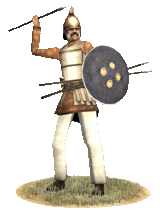 After the kingdom of Baktria attacked and seized its Indian possessions, it found the Greeks who had been living there had adapted somewhat to native ways. Gone was the close phalanx formation and the long spear, replaced by a somewhat looser but more skilled melee formation. They adopted a Phrygian style helmet, light cotton Thracian trousers, and javelins, in addition to a smaller and lighter shield. This allows them to be excellent elephant killers, as well as defeat the more lightly armored infantry of the east. They can be used as a good medium infantry, to screen the flanks and protect against elephants and cavalry while the Thureophoroi deliver the fatal melee blow. After the kingdom of Baktria attacked and seized its Indian possessions, it found the Greeks who had been living there had adapted somewhat to native ways. Gone was the close phalanx formation and the long spear, replaced by a somewhat looser but more skilled melee formation. They adopted a Phrygian style helmet, light cotton Thracian trousers, and javelins, in addition to a smaller and lighter shield. This allows them to be excellent elephant killers, as well as defeat the more lightly armored infantry of the east. They can be used as a good medium infantry, to screen the flanks and protect against elephants and cavalry while the Thureophoroi deliver the fatal melee blow.
Historically, the Indo-Greeks adapted quite well to the environment of India and prospered. Many became Buddhists, though they still remained fierce warriors, true to their Hellenic forbearers. They are an excellent medium infantry, well able to compliment other troop types and provide a versatile unit against light cavalry and elephants.
Hoplitai Indohellenikoi (Indo-Hellenic Medium Infantry)
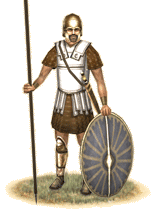 Hoplitai Indoi are the lightest component of the regular Indo-Greek phalanx line, equipped with fairly light linothrax and ptyrges, and an equally light helm, though a heavy thuroes and bronze greaves afford them substantially greater defensive coverage then the traditional hoplitai of distant Hellas. They are arrayed in a traditional, non-Makedonian phalanx to prevent a need for more regular drilling and equipped with a thuroes to compensate for the lesser defensive value inherint in this lighter formation. In Baktrian and Saka armies, they are best used to support the more expert and elite linesman around them, the Pezhetairoi Indoi and Hoplitai Indoi Beltistoi in the case of the burgeoning Baktrian empire and the Hoplitai Hellenikoi and Agema Hellenikon in the case of the Philhellenic Saka Kingdom. Hoplitai Indoi are the lightest component of the regular Indo-Greek phalanx line, equipped with fairly light linothrax and ptyrges, and an equally light helm, though a heavy thuroes and bronze greaves afford them substantially greater defensive coverage then the traditional hoplitai of distant Hellas. They are arrayed in a traditional, non-Makedonian phalanx to prevent a need for more regular drilling and equipped with a thuroes to compensate for the lesser defensive value inherint in this lighter formation. In Baktrian and Saka armies, they are best used to support the more expert and elite linesman around them, the Pezhetairoi Indoi and Hoplitai Indoi Beltistoi in the case of the burgeoning Baktrian empire and the Hoplitai Hellenikoi and Agema Hellenikon in the case of the Philhellenic Saka Kingdom.
Historically, when the Baktrian Kingdom began its fairly rapid conquest of Northern India, they transplanted a large number of Iranians - Bahlikas and Kambojas in the native tongues - with them, serving variously as lower-order administrators or yoemen in their armies, immigrants, or in their massive auxilliary corps. These men, now settled in India and affected by both the native and conquorer's culture, along with partially Hellenized local Indians and the part-Indian children of Hellenic families, formed the bulk of this varied local levy. After the conversion of the Baktrian King Menander to Buddhism, as reported in various later Buddhist texts, they likely evolved into the bulk of his successors' light linemen - particularly his own locally supported dynasty, as represented by his son Strato and both their various namesakes. Other dynasties, like that of Zoilos centered in Arachosia or that of Antialkidas at Taxila also utilized such forces, though the former's ranks probably held more soldiers of Iranian extraction and the latter of loyal dharmayavanas (Hellenized Indiands). In the time of Hellenic rule, they had a fairly limited role and their position in Baktrian armies reflects this, but under the Saka, such men were a major component of their well-trained local regulars, second in the region only to the Agema Hellenikon.
Indohellenikoi Eugeneis Hoplitai (Indo-Greek Noble Hoplites)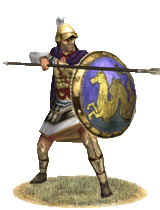 Indohellenikoi Eugeneis Hoplitai are the elite infantrymen of Hellenic India, drawn from the Indo-Greek population, be they descendants of those settled during Alexander’s invasion or recent immigrants from Baktria. They wear an evolved Boiotian helmet that offers protection against both weapons and the sun so it won’t obstruct their view. They also wear elaborately decorated bronze cuirasses with Indian motifs, pteryges, perikneimides (full greaves) and of course a heavy bronze hoplon shield to complete their armor. An iron-tipped spear is their primary weapon, but should the need arise they are also armed with an evolved kopis or Khukhri as the Indians call it, a medium sized sword of Indian steel made for slashing. In fact, when compared to the Hoplites of old, they are more mobile and have better vision of the battlefield, due to the evolved Boiotian helmet they wear. They are also equally skillful with spear or sword. These men are among the finest soldiers in India or at least in the Indus valley and western Gangetic plains and can be relied on to do their duty to a man, but a wise strategos knows to use these troops with care as there are few Hellenes in the East and their numbers are not easily replaced. In fact they, along with the Sreni (Professional guild warriors) were the ones that the Indogreek kings relied upon to hold the line. Indohellenikoi Eugeneis Hoplitai are the elite infantrymen of Hellenic India, drawn from the Indo-Greek population, be they descendants of those settled during Alexander’s invasion or recent immigrants from Baktria. They wear an evolved Boiotian helmet that offers protection against both weapons and the sun so it won’t obstruct their view. They also wear elaborately decorated bronze cuirasses with Indian motifs, pteryges, perikneimides (full greaves) and of course a heavy bronze hoplon shield to complete their armor. An iron-tipped spear is their primary weapon, but should the need arise they are also armed with an evolved kopis or Khukhri as the Indians call it, a medium sized sword of Indian steel made for slashing. In fact, when compared to the Hoplites of old, they are more mobile and have better vision of the battlefield, due to the evolved Boiotian helmet they wear. They are also equally skillful with spear or sword. These men are among the finest soldiers in India or at least in the Indus valley and western Gangetic plains and can be relied on to do their duty to a man, but a wise strategos knows to use these troops with care as there are few Hellenes in the East and their numbers are not easily replaced. In fact they, along with the Sreni (Professional guild warriors) were the ones that the Indogreek kings relied upon to hold the line.
Historically, infantrymen like these were scarce, but they still built up a fearsome reputation and Hellenes were sought after as bodyguards all over India, there is even mention of Hellenes serving as bodyguards in far away Sri Lanka. The Indo-Greek kingdoms themselves can be called Baktrian successor kingdoms as it was the Hellenes of Baktria who invaded India after the Mauryan collapse and it was Baktrian Hellenic nobles who made themselves lords in their new conquests. The Indo-Greek kingdoms were established during the civil wars and rebellions that were common in the Graeco-Baktrian Empire after 200 BC and after Baktria itself was overrun by the Saka and other nomadic groups. Evidence indicates that most infantrymen in the far eastern Hellenic kingdoms were drawn from subject peoples, except the most elite units who were made up of Hellenes and thoroughly Hellenized subjects. The same seems to have been in the case of the Indo-Greeks too, who levied large numbers of Indians to serve as infantry. Some sources indicate that Indian infantry apparently were poorly disciplined and had a low morale and thus prone to desert or rout. One battle used to illustrate this is the siege of Baktra, where 300 horsemen lead by Eukratides sallied out from the city and routed the Indo-Greek King Demetrios II’s army of 60000 men all the way to the Indus River, according to Justin (XLI,6). Apparently after this more reliable elite infantry units were raised and dispersed among the Indian infantry to try and maintain morale and lead by example.
Indohellenikoi Eugeneis Hoplitai were infantrymen who served in the Indo-Greek Kingdoms as crack troops, but units like these were likely to have fought in Baktrian armies as well, one reason being that Baktria did field elite infantry units of their own and these men would simply have been an Indo-Greek variant of those. The Saka, knew a good thing when they saw it, so not only did they keep them as a fighting force, enhancing them with their own people and fighting elements, meaning a bigger emphasis on sword than spear, a gradual shift that would take centuries to complete.
Graphical evidence includes a frieze showing a hoplite in full gear in a relief wearing the chlamys found in Butkara, National Museum of Oriental Art. There is also a Hero Stone in southern India, a dead Ksatriyas' grave, showing two rows of over hand holding spearmen, armed also with an aspis shield attacking each other, with the Hero dieing a glorious death.
Some Puranic (Indian epic) references on them... Kane quotes several minor texts in which Yavanas (Greeks) are described as barbarians (mlecchas), eaters of cow's flesh, contradictory thinkers, and having their own peculiar manner of dress and trimming of hair. (Indians at the time wore their hair long and in topknots). In other parts they are shown as different to mlecchas, above them as if leading them.
Several references to the Yavanas and their kingdom occur in Tamil epic literature and in the Ceylonese chronicle Culavamsa. In the fifth part of the Tamil epic poem Cillappatikaram, for example, the abodes of wealthy Yavanas and mercenary Yavana swordsmen are described. A Yavana kingdom existing in the North is also mentioned.
In Malinda Panha (the Buddhist monk Nagasena's account of a meeting with King Milinda or Menandros in Euthydemia, present day Sind), when the King is cornered on a difficult philosophical question, his "500 Greeks" exclaim in one voice..." Now get out of that if you can" in a most jovial mood (1st chapter). Later on they take part on the discussion as if they were expected to in some way. This indicates that they must have been pretty close to the king, the infantry part of the Basilikon Agema (King's bodyguards). In another part, he explains of a prepared military force, who is always ready for war.
The Saka used this elite force to further cement their Indian state. In time it became a mix of Yavanas, Saka and Indians, who in turn became the majority. Some Saka customs remained with them though, such as the "Ultimate Sacrifice" called "Saka" in which all those who take part, fight to the last man and either succeed or die fighting. It is not known whether a connection exists between those "Noble elites" and the Rajput-ra or "King sons'" , but the latter had that "Saka" custom as a ritual in war. Also, some of the Rajput family emblems resemble the Makedonian 16 pointed sun, which was Megas Alexandros' emblem when he started out the campaign which led to India, so many centuries before. Rajputs from the lower Indus region, in the 10th century AD fled Islamic conquest to Nepal and there they evolved into the elite Nepalese Ghurkas, who to this day carry an evolved Kopis (Khukri) and count the time by the Saka calendar.
|
 |
|
 |






















|